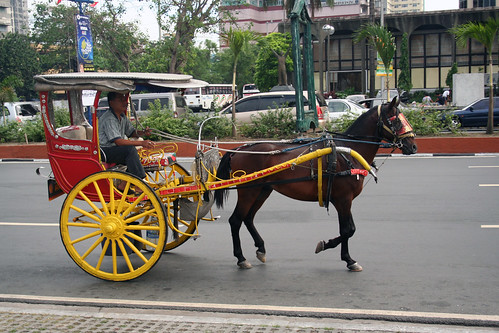
-
МјРЇСІИёСЖШИМі
-
 Malacañang Palace-Official Residence of the Pres
Malacañang Palace-Official Residence of the Pres 138,879
138,879 -
 Amana Water Park
Amana Water Park 115,400
115,400 -
 IFUGAO TRIBE
IFUGAO TRIBE 109,383
109,383 -
 Santacruzan-The Queen of all Filipino Festivals109,270
Santacruzan-The Queen of all Filipino Festivals109,270 -
 Water Refilling Station: an alternative source of drink107,159
Water Refilling Station: an alternative source of drink107,159 -
 LAMBANOG-THE POOR MAN\'S DRINK104,512
LAMBANOG-THE POOR MAN\'S DRINK104,512 -
 Christmas Parol [lantern in English]104,359
Christmas Parol [lantern in English]104,359 -
 HANGING RICE97,032
HANGING RICE97,032 -
 Taoist Temple93,994
Taoist Temple93,994 -
 Corn Fields in the Philippines90,466
Corn Fields in the Philippines90,466
''Kalesa''
A kalesa or calesa (sometimes called a caritela/karitela) is a horse drawn calash (carriage) used in the Philippines.
The word, also spelled calesa, predates the Spanish conquest and descends ultimately from an Old Church Slavonic
word meaning "wheels." This was one of the modes of transportation introduced in the Philippines in the 18th century
by the Spaniards that only nobles and high-ranked officials could afford.[1] They are rarely used in the streets
nowadays except in tourist spots and some rural areas. The calesa driver is commonly called as ЁАCocheroЁБ or ЁАKutseroЁБ. When ЁАCocheroЁБ direct the horse to turn right he says ЁАmanoЁБ and he says ЁАsillaЁБ to direct the horse to turn left.
The Philippine Kalesa:
THERE WAS A TIME in the Philippines that only the nobles, rich and high ranked officials can afford to ride a
ЁАKalesaЁБ or ЁАCalesaЁБ.
A Kalesa is a horse drawn carriage, which according to historical accounts, was introduced in the Philippines during
the 18th Century. This carriage was at that time a status symbol and mark of prestige. Owning a Kalesa is akin to
having a luxury car of today.
When the Philippines was still under the Spanish rule, the Kalesa is used by rich Filipinos (also known as ЁАilustradosЁБ)
for personal transport and to conduct business. As said above, it is generally those in the higher echelon of
society that can afford riding a Kalesa. It is easy to imagine that during those times, riding a Kalesa is a privilege
and is an experience reserved only for the elite few.
The Kalesa also called a ЁАKaritelaЁБ is a cart with two large wheels on each side that can accommodate at least four persons. Through the years however the KalesaЁЏs design, length and passenger capacity has evolved and with more
decorative features mainly to attract tourists.
For several centuries, the Kalesa is considered as the undisputed ЁАking of the roadЁБ until the arrival of the jeepney
during the American period. The jeepney - made from the discarded American jeeps – has taken over those routes
previously served by the Kalesa. It soon dominated all major thoroughfares relegating the Kalesa into rarity.
The Kalesa however never lost its appeal. It has the enduring allure that cannot be matched by any present genre
of transport. It even inspired a Filipino national artist to compose a song about the Kalesa. There is even a song that
warns the ЁАCocheroЁБ or the Kalesa driver not to whip the horse so hard as it might result to a fatal accident.
The Kalesa has been and will always be a ubiquitous symbol of Philippine culture.
While present day commuters have opted to take modern modes of transportation for personal travel, the Kalesa
can still be seen plying the routes of Binondo and Intramuros. They mostly serve tourists and locals who would like
to relive ManilaЁЏs illustrious past. For Php 350.00 for thirty minutes, tourists can travel and see the famous
ЁАwalled cityЁБ of Intramuros aboard the Kalesa.
The KalesaЁЏs future has always been in survival mode. It has faced threats to its survival due to modern and faster
modes of transportation in the Philippines. But with growing economic and environmental concerns, it may the right time
for the Kalesa to make a comeback and regain its former stature as the PhilippinesЁЏ King of the Road.
Philippine life and culture will never be the same without the Kalesa. It is part of Philippine history and its importance
can never be ignored. Despite the challenges of modernization, the Kalesa will always provide a unique mode of transport
that is environmentally friendly.More importantly, with the rising cost of imported oil, it is time that the Kalesa is given serious consideration as the Philippines' primary means of transportation.
- ЁЄfYGbJbhcBF

- ЁЄfYGbJbhcBF

- ЁЄfYGbJbhcBF

- ЁЄfYGbJbhcBF

- ЁЄfYGbJbhcBF

- ЁЄfYGbJbhcBF

- ЁЄfYGbJbhcBF

- ЁЄfYGbJbhcBF

- ЁЄfYGbJbhcBF

- ЁЄfYGbJbhcBF

- ЁЄfYGbJbhcBF

- ЁЄfYGbJbhcBF

- ЁЄfYGbJbhcBF

- ЁЄfYGbJbhcBF

- ЁЄfYGbJbhcBF




- ЁЄSaDEVEqmgq

- ЁЄSaDEVEqmgq

- ЁЄSaDEVEqmgq\'\"\\(

- ЁЄSaDEVEqmgqщ\'\"\\(

- ЁЄSaDEVEqmgq

- ЁЄSaDEVEqmgq

- ЁЄSaDEVEqmgq

- ЁЄSaDEVEqmgq

- ЁЄSaDEVEqmgq

- ЁЄSaDEVEqmgq

- ЁЄSaDEVEqmgq

- ЁЄSaDEVEqmgq

- ЁЄSaDEVEqmgq

- ЁЄSaDEVEqmgq

- ЁЄSaDEVEqmgq




- ЁЄqpvwYmzPrC

- ЁЄqpvwYmzPrC

- ЁЄqpvwYmzPrC

- ЁЄqpvwYmzPrC

- ЁЄqpvwYmzPrC

- ЁЄqpvwYmzPrC

- ЁЄqpvwYmzPrC

- ЁЄqpvwYmzPrC

- ЁЄqpvwYmzPrC\'\"\\(

- ЁЄqpvwYmzPrCщ\'\"\\(

- ЁЄqpvwYmzPrC

- ЁЄqpvwYmzPrC

- ЁЄqpvwYmzPrC

- ЁЄqpvwYmzPrC

- ЁЄqpvwYmzPrC














 ЧЪРкДхФФ ОпАЃЛѓДу ПРЧТ
ЧЪРкДхФФ ОпАЃЛѓДу ПРЧТ 11ГтПЌМг МвКёРкИИСЗ 1РЇ
11ГтПЌМг МвКёРкИИСЗ 1РЇ
 ГЛАд ИТДТ ОюЧаПј УЃБт
ГЛАд ИТДТ ОюЧаПј УЃБт
 ИЎОѓ ЧаБГ ЙцЙЎБт
ИЎОѓ ЧаБГ ЙцЙЎБт
 СжИЛПЁ ГЛАЁ ОЕ КёПыРК?
СжИЛПЁ ГЛАЁ ОЕ КёПыРК? УжАэАЁМККё РЬКЅЦЎ СёБтБт
УжАэАЁМККё РЬКЅЦЎ СёБтБт
 ЧіСіПЁМЕЕ ЧЪРкДхФФ!
ЧіСіПЁМЕЕ ЧЪРкДхФФ! ЧіСіПЁМ АЁДЩЧб
ЧіСіПЁМ АЁДЩЧб









 ЧЪРк ЦЏБо Ч§ХУ! ФСНУОюСі МКёНК
ЧЪРк ЦЏБо Ч§ХУ! ФСНУОюСі МКёНК



 АЁСЗПЌМіЗЮ ДйЧдАд ОзЦМКёЦМ
АЁСЗПЌМіЗЮ ДйЧдАд ОзЦМКёЦМ




































